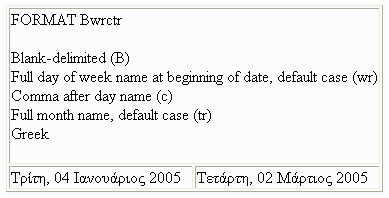Reference: Usage Notes for the DATETRAN Function
- The output field, though it must be type A, and not AnV, may in fact contain variable length information, since the lengths of month names and day names can vary, and also month and day numbers may be either one or two bytes long if a zero-suppression option is selected. Unused bytes are filled with blanks.
- All invalid and inconsistent inputs result in all blank output strings. Missing data also results in blank output.
- The base dates (1900-12-31
and 1900-12 or 1901-01) are treated as though the DATEDISPLAY setting
were ON (that is, not automatically shown as blanks). To suppress the
printing of base dates, which have an internal integer value of
0, test for 0 before calling DATETRAN. For example:
RESULT/A40 = IF DATE EQ 0 THEN ' ' ELSE DATETRAN (DATE, '(YYMD)', '(.t)', 'FR', 40, 'A40'); - Valid translated date components are contained in files named DTLNGlng where lng is a three-character code that specifies the language. These files must be accessible for each language into which you want to translate dates.
- If you use a terminal emulator program, it must be set to use a code page that can display the accent marks and characters in the translated dates. You may not be able to display dates translated into European and Asian characters at the same time. Similarly, if you want to print the translated dates, your printer must be capable of printing the required characters.
- The DATETRAN function is not supported in Dialogue Manager.
Example: Using the DATETRAN Function
The following request prints the day of the week in the default case of the specific language:
DEFINE FILE VIDEOTRK TRANS1/YYMD=20050104; TRANS2/YYMD=20051003;
DATEW/W=TRANS1 ; DATEW2/W=TRANS2 ; DATEYYMD/YYMDW=TRANS1 ; DATEYYMD2/YYMDW=TRANS2 ;
OUT1A/A8=DATETRAN(DATEW, '(W)', '(wr)', 'EN', 8 , 'A8') ; OUT1B/A8=DATETRAN(DATEW2, '(W)', '(wr)', 'EN', 8 , 'A8') ; OUT1C/A8=DATETRAN(DATEW, '(W)', '(wr)', 'ES', 8 , 'A8') ; OUT1D/A8=DATETRAN(DATEW2, '(W)', '(wr)', 'ES', 8 , 'A8') ; OUT1E/A8=DATETRAN(DATEW, '(W)', '(wr)', 'FR', 8 , 'A8') ; OUT1F/A8=DATETRAN(DATEW2, '(W)', '(wr)', 'FR', 8 , 'A8') ; OUT1G/A8=DATETRAN(DATEW, '(W)', '(wr)', 'DE', 8 , 'A8') ; OUT1H/A8=DATETRAN(DATEW2, '(W)', '(wr)', 'DE', 8 , 'A8') ; END
TABLE FILE VIDEOTRK HEADING "FORMAT wr" "" "Full day of week name at beginning of date, default case (wr)" "English / Spanish / French / German" "" SUM OUT1A AS '' OUT1B AS '' TRANSDATE NOPRINT OVER OUT1C AS '' OUT1D AS '' OVER OUT1E AS '' OUT1F AS '' OVER OUT1G AS '' OUT1H AS ''ON TABLE HOLD FORMAT HTML ON TABLE SET PAGE-NUM OFF ON TABLE SET STYLE * GRID=OFF, $ END
The output is:
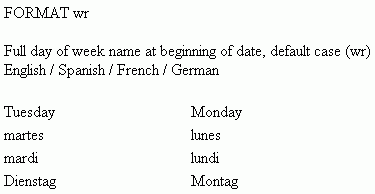
The following request prints a blank delimited date with an abbreviated month name in English. Initial zeros in the day number are suppressed, and a suffix is added to the end of the number:
DEFINE FILE VIDEOTRK TRANS1/YYMD=20050104; TRANS2/YYMD=20050302;
DATEW/W=TRANS1 ; DATEW2/W=TRANS2 ; DATEYYMD/YYMDW=TRANS1 ; DATEYYMD2/YYMDW=TRANS2 ;
OUT2A/A15=DATETRAN(DATEYYMD, '(MDYY)', '(Btdo)', 'EN', 15, 'A15') ; OUT2B/A15=DATETRAN(DATEYYMD2, '(MDYY)', '(Btdo)', 'EN', 15, 'A15') ; END
TABLE FILE VIDEOTRK HEADING "FORMAT Btdo" "" "Blank-delimited (B)" "Abbreviated month name, default case (t)" "Zero-suppress day number, end with suffix (do)" "English" "" SUM OUT2A AS '' OUT2B AS '' TRANSDATE NOPRINTON TABLE HOLD FORMAT HTML ON TABLE SET PAGE-NUM OFF END
The output is:
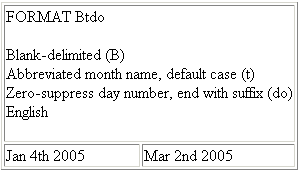
The following request prints a blank delimited date, with an abbreviated month name in German. Initial zeros in the day number are suppressed, and a period is added to the end of the number:
DEFINE FILE VIDEOTRK TRANS1/YYMD=20050104; TRANS2/YYMD=20050302;
DATEW/W=TRANS1 ; DATEW2/W=TRANS2 ; DATEYYMD/YYMDW=TRANS1 ; DATEYYMD2/YYMDW=TRANS2 ;
OUT3A/A12=DATETRAN(DATEYYMD, '(DMYY)', '(Btdp)', 'DE', 12, 'A12'); OUT3B/A12=DATETRAN(DATEYYMD2, '(DMYY)', '(Btdp)', 'DE', 12, 'A12'); END
TABLE FILE VIDEOTRK HEADING "FORMAT Btdp" "" "Blank-delimited (B)" "Abbreviated month name, default case (t)" "Zero-suppress day number, end with period (dp)" "German" "" SUM OUT3A AS '' OUT3B AS '' TRANSDATE NOPRINTON TABLE HOLD FORMAT HTML ON TABLE SET PAGE-NUM OFF END
The output is:
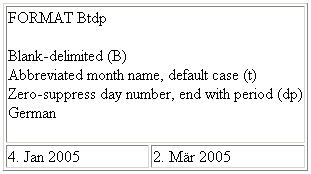
The following request prints a blank delimited date in French, with a full day name at the beginning and a full month name, in lowercase (the default for French):
DEFINE FILE VIDEOTRK TRANS1/YYMD=20050104; TRANS2/YYMD=20050302;
DATEW/W=TRANS1 ; DATEW2/W=TRANS2 ; DATEYYMD/YYMDW=TRANS1 ; DATEYYMD2/YYMDW=TRANS2 ;
OUT4A/A30 = DATETRAN(DATEYYMD, '(DMYY)', '(Bwrtr)', 'FR', 30, 'A30'); OUT4B/A30 = DATETRAN(DATEYYMD2, '(DMYY)', '(Bwrtr)', 'FR', 30, 'A30'); END
TABLE FILE VIDEOTRK HEADING "FORMAT Bwrtr" "" "Blank-delimited (B)" "Full day of week name at beginning of date, default case (wr)" "Full month name, default case (tr)" "English" "" SUM OUT4A AS '' OUT4B AS '' TRANSDATE NOPRINTON TABLE HOLD FORMAT HTML ON TABLE SET PAGE-NUM OFF END
The output is:

The following request prints a blank delimited date in Spanish with a full day name at the beginning in lowercase (the default for Spanish), followed by a comma, and with the word “de” between the day number and month and between the month and year:
DEFINE FILE VIDEOTRK TRANS1/YYMD=20050104; TRANS2/YYMD=20050302;
DATEW/W=TRANS1 ; DATEW2/W=TRANS2 ; DATEYYMD/YYMDW=TRANS1 ; DATEYYMD2/YYMDW=TRANS2 ;
OUT5A/A30=DATETRAN(DATEYYMD, '(DMYY)', '(Bwrctrde)', 'ES', 30, 'A30'); OUT5B/A30=DATETRAN(DATEYYMD2, '(DMYY)', '(Bwrctrde)', 'ES', 30, 'A30'); END
TABLE FILE VIDEOTRK HEADING "FORMAT Bwrctrde" "" "Blank-delimited (B)" "Full day of week name at beginning of date, default case (wr)" "Comma after day name (c)" "Full month name, default case (tr)" "Zero-suppress day number (d)" "de between day and month and between month and year (e)" "Spanish" "" SUM OUT5A AS '' OUT5B AS '' TRANSDATE NOPRINTON TABLE HOLD FORMAT HTML ON TABLE SET PAGE-NUM OFF END
The output is:
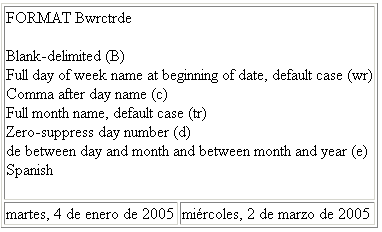
The following request prints a date in Japanese characters with a full month name at the beginning, in the default case and with zero suppression:
DEFINE FILE VIDEOTRK TRANS1/YYMD=20050104; TRANS2/YYMD=20050302;
DATEW/W=TRANS1 ; DATEW2/W=TRANS2 ; DATEYYMD/YYMDW=TRANS1 ; DATEYYMD2/YYMDW=TRANS2 ;
OUT6A/A30=DATETRAN(DATEYYMD , '(YYMD)', '(Ktrd)', 'JA', 30, 'A30'); OUT6B/A30=DATETRAN(DATEYYMD2, '(YYMD)', '(Ktrd)', 'JA', 30, 'A30'); END
TABLE FILE VIDEOTRK HEADING "FORMAT Ktrd" "" "Japanese characters (K in conjunction with the language code JA)" "Full month name at beginning of date, default case (tr)" "Zero-suppress day number (d)" "Japanese" "" SUM OUT6A AS '' OUT6B AS '' TRANSDATE NOPRINTON TABLE HOLD FORMAT HTML ON TABLE SET PAGE-NUM OFF END
The output is:
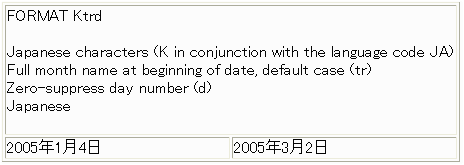
The following request prints a blank delimited date in Greek with a full day name at the beginning in the default case, followed by a comma, and with a full month name in the default case:
DEFINE FILE VIDEOTRK TRANS1/YYMD=20050104; TRANS2/YYMD=20050302;
DATEW/W=TRANS1 ; DATEW2/W=TRANS2 ; DATEYYMD/YYMDW=TRANS1 ; DATEYYMD2/YYMDW=TRANS2 ;
OUT7A/A30=DATETRAN(DATEYYMD , '(DMYY)', '(Bwrctr)', 'GR', 30, 'A30'); OUT7B/A30=DATETRAN(DATEYYMD2, '(DMYY)', '(Bwrctr)', 'GR', 30, 'A30'); END
TABLE FILE VIDEOTRK HEADING "FORMAT Bwrctrde" "" "Blank-delimited (B)" "Full day of week name at beginning of date, default case (wr)" "Comma after day name (c)" "Full month name, default case (tr)" "Greek" "" SUM OUT7A AS '' OUT7B AS '' TRANSDATE NOPRINTON TABLE HOLD FORMAT HTML ON TABLE SET PAGE-NUM OFF END
The output is:
